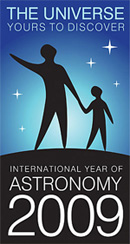 A large cluster of astronomers were sighted in Paris last week at the official launch of the International Year of Astronomy. Planned to coincide with the 400th anniversary of Galileo’s first observations of the heavens with a telescope, the year, also known as IYA 2009, will commence under the theme ‘The Universe, Yours to Discover.’ The celebration is meant to reignite the wonder that the starry skies have always provoked in humankind and promote astronomy’s contribution to society, culture and development.
A large cluster of astronomers were sighted in Paris last week at the official launch of the International Year of Astronomy. Planned to coincide with the 400th anniversary of Galileo’s first observations of the heavens with a telescope, the year, also known as IYA 2009, will commence under the theme ‘The Universe, Yours to Discover.’ The celebration is meant to reignite the wonder that the starry skies have always provoked in humankind and promote astronomy’s contribution to society, culture and development.
“People have always looked to the sky for answers to the questions ‘How did we get here?’ and ‘Why are we here?’” said Koïchiro Matsuura, Director-General of UNESCO, the United Nations Educational, Scientific and Cultural Organization.
The gala opening at the agency’s headquarters gathered astronauts, artists, diplomats, industrialists and astronomy undergraduates from over 100 countries.
“The sky belongs to everybody,” Mr. Matsuura said. “Astronomy is an instrument to promote peace and understanding among nations.”
The two-day launch ceremony featured presentations by Nobel prize winners Bob Wilson and Baruch Blumberg, reports of the latest discoveries, discussions on the role of astronomy in culture and public engagement, real-time astronomical observation and a closing performance by the Grammy-winning Kronos Quartet. (See the video trailer announcing IYA2009 at the bottom of this article.)
Hundreds of events on the global, national and regional levels have also been planned for the first weeks of the Year in conjunction with the International Astronomical Union (IAU). The website www.astronomy2009.org has all the latest news and activities, along with an email newsletter to keep you up to date with the celebration.
The National Science Foundation (NSF) has devoted millions of dollars to underwrite IYA 2009 activities and initiatives, such as the Galileoscope Project, an official cornerstone and perhaps the most visible project of IYA 2009, will enable children to experience observation via a sophisticated yet affordable ($10/each) telescope. Working with two of the best optical designers in the world, the Galileoscope creates a true-color corrected view through a high quality eyepiece in a telescope with a baffle design optimized for looking at bright objects like the Moon and planets. “Hands-On Optics” teaching kits are part of a 4-year NSF-sponsored project used by over 20,000 students nationwide, mainly in after-school settings.
“400 Years of the Telescope” is an interactive, multimedia project that will enable the public to participate in real and virtual telescope experiences and understand the practical advances that the telescope has made possible. A partnership between PBS, NSF, leading astronomers, and two U.S. planetariums, culminated in a two-hour, high-definition documentary that will air twice on PBS in 2009. And, a full-dome and traditional 30-minute planetarium program will be made available in 12 foreign languages, with free national and international distribution to 750 planetariums throughout the United States.
The Great World Wide Star Count, in conjunction with planetariums and scientific societies, will map tens of thousands of observations taken from all seven continents and 60 countries around the world.
Watch the IYA 2009 trailer below:
Related Story: The Philadelphia Inquirer outlined upcoming developments in the world of big telescopes, 400 years after Galileo’s first observation, called, 2009 will be a big year for titanic telescopes




















This is great. We have a tiny little Planetarium near me and they are putting on special lectures – I’m so looking forward to learning more.
S
x